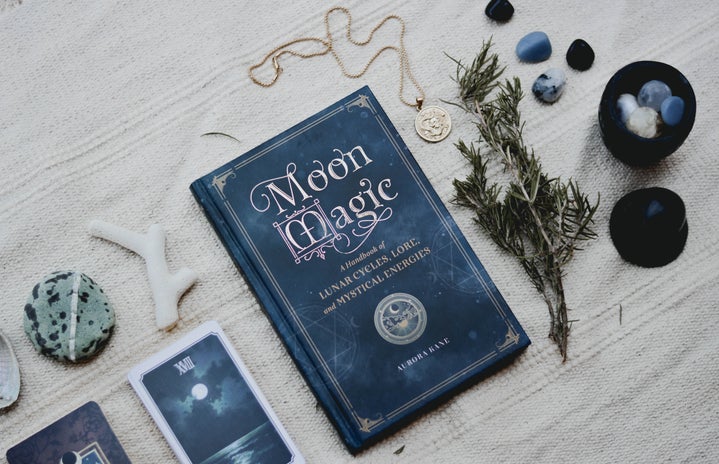For several years, the concept of Wicca has snagged my interest, especially as someone who was not raised to be particularly religious, because Wicca is a pagan religion that is very much tied to nature. Some Wiccans–often called “witches” regardless of gender, though not all witches are Wiccan– worship a God and Goddess (who together represent the balance of nature) or pick and choose deities from different religions, while others are atheistic, and the religion focuses largely on nature and the elements. Many witches practice magic by interacting with the earth’s natural energy forces, and rituals are often performed to honor the Triple Goddess and the Horned God, among other deities. Many use an altar, or a designated area with all the needed supplies to perform rituals and honor the gods. The religion is commonly represented by a pentacle, and tarot cards, crystals, and incense are often tools used in their practices. Most Wiccans choose to practice on their own, but some meet in groups to carry out their rituals, the groups known as “covens.” Additionally, many Wiccans believe in reincarnation after death, and that one is reincarnated until they have learnt all the knowledge in the world before retiring to the afterlife. Next I will give a brief overview of the eight Wiccan holidays, known as “sabbats,” and how they are commonly celebrated.
- Yule/Winter Solstice
Yule is celebrated on the winter solstice, which typically falls between December 20 and December 23, and centers around rebirth and the return of light, as from that point forward the days will become longer. For those who believe in the God and Goddess, it is said that the God is reborn on Yule, birthed by the Mother Goddess (also referred to as Mother Earth, the Triple Goddess, etc.). Many Yule traditions are practiced in Christianity as well as Wicca, such as the lighting of Yule logs and the use of red, green, white, and gold colors for decorating. Altars are also typically decorated with winter flora, such as pine branches and holly.
- Imbolc
Imbolc occurs on February 2, halfway between Yule and the spring equinox. It is a celebration of the end of winter and beginning of spring, and is thought of as a time for cleansing. This can often include energetically cleansing your spaces and belongings with the use of light, whether from the sun or a candle or lamp. In some instances, dairy products are consumed to honor the holiday’s namesake, an Irish word pertaining to the birth of the first lambs of spring.
- Ostara/Spring Equinox
Ostara takes place between March 19 and March 23 and is seen as a time to celebrate balance between extremes (for instance, spring being the balance between the extremes of summer and winter). This holiday is often celebrated by placing spring flowers on the altar, or filling a small cauldron or bowl with spring water and placing flower petals on the surface.
- Beltane
This holiday is observed on May 1, and marks the final transition from spring into summer. It is a time of passion and fertility, and many Wiccan weddings are held around this time. It is during this time that the God and Goddess are believed to be joined together in order for all living things to thrive, and for this reason it is often viewed as a time of sensuality. Fire is often used to decorate altars, whether real or not, and long hair may be braided to symbolize the union of the God and Goddess.
- Litha/Summer Solstice
Litha is celebrated between June 20 and June 22 and marks the height of the sun’s power as the longest day of the year. Like Beltane, fire is often used in rituals for this holiday, and altars are decorated with summer flora. Many rituals and celebrations take place outdoors around noon, as the sun is at its brightest and highest in the sky at this time. Another common name for this holiday is Midsummer.
- Lammas
Lammas takes place between August 1 and August 2, and largely centers around the beginning of harvest season. Some believe that the God puts his power into the crops which are then harvested, and in some cases people will make food such as bread with grains they have harvested and give the product as an offering to the God. Other ways to celebrate include decorating one’s altar with fall colors and imagery, as well as holding a feast.
- Mabon/Autumn Equinox
Mabon is celebrated between September 21 and September 24, when the days and nights are of equal length, at the peak of harvest season. It is seen as a day of rest to enjoy the fruits of one’s labor, and is often celebrated with a feast of seasonal vegetables and decorating one’s altar with candles, acorns, fallen leaves, and other flora.
- Samhain
Samhain is observed on either October 31 or November 1. It marks the symbolic death of the God before he is reborn from the Goddess later on, as well as the start of winter. Many believe that on Samhain, the veil between physical and spiritual worlds is at its thinnest. Traditions are often similar to those of Halloween, and honoring one’s ancestors is a large central theme. To celebrate, many decorate their altars with pictures of their passed loved ones, pumpkins, and other seasonal flora, as well as leaving food out for wandering spirits who may pass by.
I hope this short guide to Wiccan holidays and practices provides a helpful insight into this often-misunderstood belief system, and that it may have piqued your interest. I wish you all a happy Beltane; blessed be!





